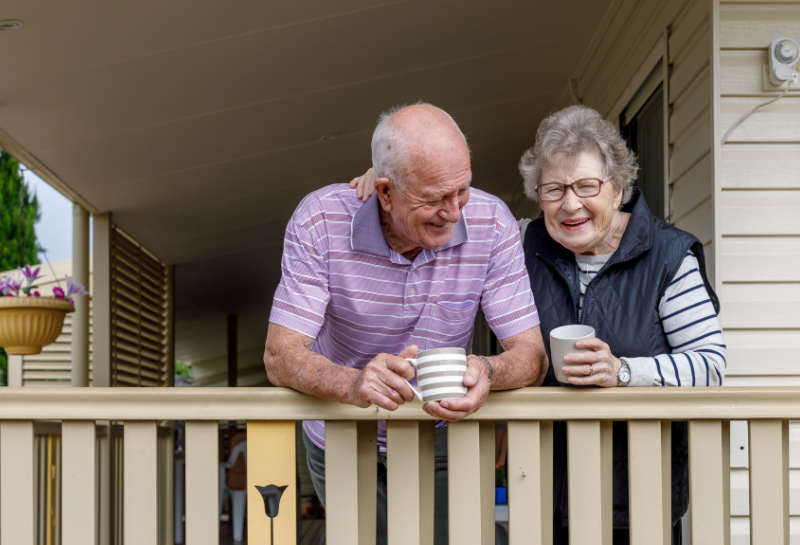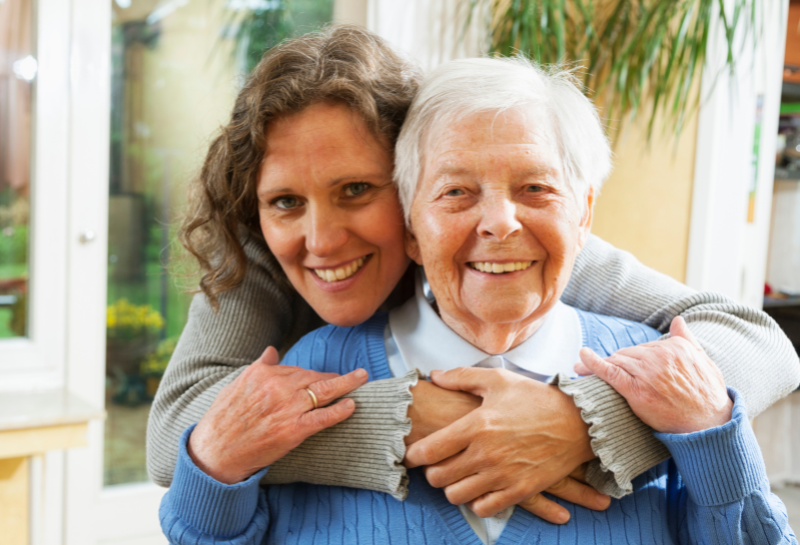Older Adult Isolation This Fall — How Volunteers Make a Difference
As the leaves begin to fall and temperatures drop, many older adults face increased risks of isolation and loneliness. The cold weather and increased duration of darkness make this time even more challenging for seniors. People of all ages can experience Seasonal Affective Disorder (SAD).
According to the National Institute of Mental Health (NIH), SAD is “a type of depression that comes and goes with the seasons, typically starting in the late fall and early winter and going away during the spring and summer.” This condition shares symptoms that we see in isolated seniors, including anxiety, poor appetite, and social withdrawal.
Aging-in-place organizations like DSCC rely on the dedication of volunteers to bridge this gap, providing essential support and companionship to seniors in need.
What is Social Isolation?
When older adults have limited or no contact with others but would prefer more, they are socially isolated. Social isolation can lead to loneliness and can impact physical and mental health.
Older adults are more likely than others to feel socially isolated because they have experienced life transitions such as:
- The loss of family, friends, or a partner
- A chronic or limiting medical condition
- Retirement
- Becoming a caregiver for a spouse or partner
- Change in living arrangements?
Over four decades of research has produced robust evidence that lacking social connection— and in particular, scoring high on measures of social isolation—is associated with a significantly increased risk for early death from all causes.
This fall, volunteers can make a difference in the lives of older adults by helping them stay engaged, connected, and safe in their homes.
Volunteers play a vital role in combating senior isolation. Their contributions are indispensable to aging-in-place organizations like DSCC.
The Impact of Social Isolation on Seniors in The Cold
As the colder months approach, social isolation among older adults is a serious concern that our communities must address.
The impact of social isolation on seniors who stay indoors more, socialize less, and engage less in activities shows up in many ways:
- Increased Risk of Depression — Social isolation during the cold months can exacerbate feelings of loneliness, leading to higher rates of depression.
Limited interaction with others, compounded by shorter daylight hours and colder weather, can contribute to Seasonal Affective Disorder (SAD), increasing emotional strain.
- Decline in Physical Health — Depression caused by social isolation can impact physical health.
When older adults experience feelings of loneliness and sadness, they are more likely to become inactive, leading to muscle weakness, mobility issues, and a greater risk of falls.
According to the U.S. Centers for Disease Control and Prevention (CDC) and other fall research:
- Fourteen million, or 1 in 4 Americans age 65+, falls each year.
- Falls are the leading cause of fatal and non-fatal injuries among older adults.
- In 2021, falls caused 38,000 deaths among those age 65+, and emergency departments reported 3 million visits due to older adult falls.
In addition, the combination of emotional strain and a sedentary lifestyle during the colder months can exacerbate health problems like heart disease, high blood pressure, and chronic pain.
- Cognitive Decline—Isolation can lead to a lack of these stimulating activities, increasing the risk of cognitive decline and memory loss in older adults.
Engaging in conversations and mental stimulation are crucial for maintaining cognitive health.
- Poor Nutrition and Health Care — When seniors are socially isolated, they may neglect their nutritional needs or miss medical appointments.
Cold weather can make it difficult for them to leave their homes for meals or checkups, further impacting their physical well-being.
- Increased Risk of Emergencies and Scams — Isolation during the cold months increases the risk of emergencies like falls or health issues because there may be no one around to provide immediate assistance.
Additionally, seniors spending more time indoors with fewer opportunities for social interactions can become more vulnerable to phone scams and fraud.
Regular check-ins and community support can mitigate both physical and financial dangers.
Understanding the toll social isolation takes on older adults in their homes is vital to positive action in community support and helpful intervention.
Understanding and taking action is where volunteers can play a critical role with DSCC and other aging-in-place organizations.
Why Volunteering Matters
Here are just three ways that volunteering matters to DSCC and other aging-in-place non-profits:
- Social Connection for Seniors — Volunteers provide regular check-ins, friendly visits, and phone calls that help mitigate loneliness and isolation among older adults.
Volunteers’ presence offers essential social interaction, keeping seniors connected and engaged within their communities, especially during colder months when getting out can be more complicated.
- Safety and Well-Being — Volunteers assist with home safety checks and modifications, helping to ensure the security of older adults’ living environments.
Volunteers help with tasks like installing grab bars, testing smoke detectors, and offering seasonal modifications that protect seniors from accidents, such as falls, which are more common in cold weather months.
- Nutritional Support and Wellness Checks — Through services like Meals on Wheels, volunteers deliver nutritious meals to seniors who cannot shop or cook for themselves during cold weather.
Delivering meals also serves as a wellness check, ensuring seniors are well-fed, safe, and healthy.
Volunteers are the backbone of organizations like DSCC, ensuring seniors remain safe, connected, and engaged.
By dedicating time and effort, volunteers help aging-in-place non-profits bridge the gap between limited resources and the growing needs of older adults.
“As life expectancy rises, we have a unique opportunity to redefine what it means to grow older. At CDC, we envision a world where aging is celebrated and everyone has the opportunity to thrive,” says Debra Houry, M.D., M.P.H., CDC’s chief medical officer. “This framework serves as a roadmap for building age-friendly communities that prioritize the health and wellbeing of older adults.”
Whether providing emotional support, assisting with safety measures, or ensuring access to nutritious meals, volunteering’s impact cannot be overstated.
A Final Thought
Volunteers are the heart of aging-in-place organizations like DSCC. They profoundly impact older adults’ lives by providing essential care and companionship through aging-in-place organizations like DSCC.
Whether offering social connection, ensuring home safety, or delivering nutritious meals, volunteers help create safer, healthier, and more engaged communities for seniors.
If you want to give your time and make a difference, consider volunteering with DSCC. Your efforts can play a critical role in helping seniors remain connected and safe in their homes this fall and beyond.
Contact DSCC today to learn more about how you can get involved. Together, we can address the challenges of senior isolation and create a more supportive community for our aging population.
Sources:
- Illinois Department on Aging
- The U.S. Department of Health and Human Services, May 2024
- National Council on Aging, June 2024
- Surgeon General’s Advisory 2023, Our Epidemic of Loneliness and Isolation
More Articles That Might Interest You
Aging in Crisis: The Challenges Seniors Face Staying at Home Without Help
Aging in Crisis: The Challenges Seniors Face Staying at Home Without Help As seniors face the desire [...]
This Giving Tuesday, Give with Purpose: Support Aging-in-Place Non-Profits
This Giving Tuesday, Give with Purpose: Support Aging-in-Place Non-Profits As purpose-driven corporate giving becomes a strategic priority, companies [...]
Honoring Family Caregivers: A Lifeline of Support in November and Beyond
Honoring Family Caregivers: A Lifeline of Support in November and Beyond November is National Family Caregivers Month, [...]










